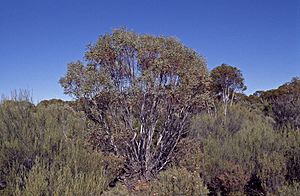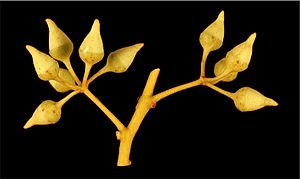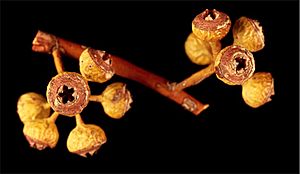Tammin mallee facts for kids
Quick facts for kids Tammin mallee |
|
|---|---|
 |
|
| Eucalyptus leptopoda subsp. subluta near Menzies | |
| Scientific classification | |
| Genus: |
Eucalyptus
|
| Species: |
leptopoda
|
| Synonyms | |
|
Eucalyptus angustifolia Turcz. nom. illeg. |
|
The Eucalyptus leptopoda, often called the Tammin mallee, is a unique plant. It is usually a mallee, which means it's a small, bushy tree with many stems growing from the ground. Sometimes, it can grow into a single-stemmed tree. This plant is found only in Western Australia, making it endemic to that area.
The Tammin mallee has smooth bark that can be grey or brownish. Sometimes, the bark near the bottom of the plant is a bit rough. Its adult leaves are long and narrow, often slightly curved. When it blooms, it has creamy white flowers. These flowers usually grow in groups of seven to eleven. After the flowers, it produces round, flattened fruits.
Contents
What Does the Tammin Mallee Look Like?
The Tammin mallee is typically a mallee, growing between 1 and 8 meters (about 3 to 26 feet) tall. It has a special woody swelling at its base called a lignotuber. This helps the plant regrow after fires.
Its bark is usually smooth and can be grey or grey-brown. Sometimes, the bark near the bottom is flaky or rough. Young plants and new shoots (called coppice regrowth) have dull green leaves. These leaves are long and narrow, about 5 to 13 centimeters (2-5 inches) long. They are attached to a short stalk called a petiole.
Adult leaves are also dull green or grey-green on both sides. They are usually long and narrow or slightly curved. These leaves are about 7.5 to 12.5 centimeters (3-5 inches) long. Their petioles are a bit longer, about 0.5 to 1.8 centimeters (0.2-0.7 inches).
The flower buds grow in groups of seven to eleven. They are found where the leaves meet the stem. Each group of buds sits on a stalk called a peduncle, which is 0.8 to 1.5 centimeters (0.3-0.6 inches) long. Each individual bud has its own small stalk, a pedicel, about 0.5 to 1 centimeter (0.2-0.4 inches) long.
Mature buds are oval or round, about 0.8 to 1.1 centimeters (0.3-0.4 inches) long. They have a beak-shaped cap called an operculum. The Tammin mallee flowers between September and March. Its flowers are white, cream, or yellow. After flowering, the plant produces fruit. This fruit is a round, flattened seed pod called a capsule. It is about 0.4 to 0.7 centimeters (0.15-0.27 inches) long and 0.6 to 1 centimeter (0.2-0.4 inches) wide. The parts that release the seeds stick out above the rim of the fruit.
How the Tammin Mallee Got its Name
The Tammin mallee was first officially described in 1867. A botanist named George Bentham gave it its scientific name, Eucalyptus leptopoda. This description was published in a book called Flora Australiensis. The first plant sample used for this description was collected by James Drummond.
The second part of its scientific name, leptopoda, comes from ancient Greek words. "Lepto" means "thin," "narrow," or "slender." "Poda" means "foot." This name refers to the slender pedicels, which are the small stalks holding the individual flower buds.
Scientists have also identified four different types, or subspecies, of Eucalyptus leptopoda. These subspecies were described in 1992 by Lawrie Johnson and Ken Hill. They are slightly different from each other in their leaves or fruit shape.
Where Does the Tammin Mallee Grow?
The Tammin mallee is found only in Western Australia. It grows in the Mid West, Wheatbelt, and western parts of the Goldfields-Esperance regions.
You can often find it growing in sandy areas like sand plains, dunes, and small hills. It prefers sandy or loamy soils, which are sometimes mixed with gravel. These soils are often found over or near areas of laterite, a type of reddish soil or rock.
Is the Tammin Mallee Protected?
Good news! All four subspecies of E. leptopoda are considered "not threatened." This means they are not currently at risk of disappearing. The Western Australian Government's Department of Parks and Wildlife has given them this status.



